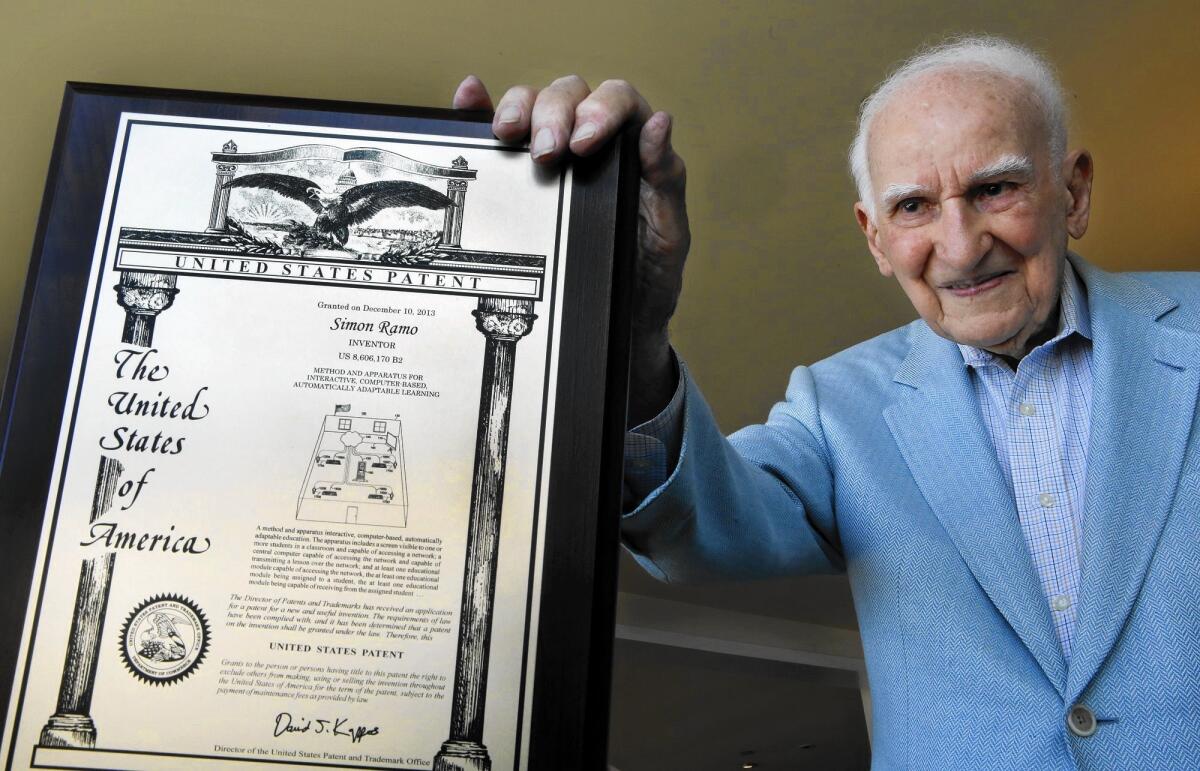How I Made It: How I Made It: Simon ‘Si’ Ramo

The gig: Simon “Si” Ramo helped lead the Cold War development of the intercontinental ballistic missile, which could send a nuclear warhead thousands of miles. The aerospace pioneer co-founded two Fortune 500 companies, including TRW Inc., for which he built a sprawling campus in Redondo Beach known as Space Park. There, engineers invented rocket-destroying lasers, a robotic space probe to Jupiter known as Pioneer 10, and engines for the Apollo moon-landing missions. Ramo has received dozens of awards, including the Presidential Medal of Freedom. His name appears on dozens of patents. Last year, at age 100, he received Patent #8606170B2 for a computer-based learning invention — becoming the oldest person ever to receive a patent.
Excelling at time management: Even as a teen, Ramo had detailed goals. Yet he didn’t have enough time to accomplish them. Besides hours of homework and his beloved violin lessons, he worked a couple of hours each day, and all day Saturday, at his father’s store during the Depression. To reach his aspirations and still have time for music, every Sunday night Ramo made a list of his priorities for the week on a card that he kept in his pocket. “I had learned to use time to the greatest advantage,” he explained. It worked so well that he graduated from high school at age 16, from the University of Utah at 20 and from Caltech with two doctoral degrees at 23.
Learning business as a boy: His father’s store in Salt Lake City sold overalls, gloves and other goods needed by carpenters and other working men in Salt Lake City. His father counted on Ramo not just to help him stock shelves but also to be the store’s chief window dresser, accountant and writer of correspondence.
Taking calculated risks: Ramo repeatedly made successful bets of his limited time and money. When he was 16 and already a high school senior, he didn’t have the money to attend college. But he came up with a plan: He aimed to win a music contest whose prize was a full-ride scholarship to the University of Utah. To increase his odds, Ramo spent the $300 he had saved for college on a European violin. He won the prize, which allowed him to study whatever he desired. He chose engineering.
Choosing the right friends: Ramo became friends with Dean Wooldridge, while the two were classmates at Caltech. “He could understand anything almost immediately, it seemed,” Ramo said. “I was much more interested in new ideas. He was a master of old ideas. Between us we realized we were quite a pair.”
The two were soon working together at Howard Hughes’ famed aviation company, and then walked out to start their own firm in a one-room Los Angeles office. Less than a year later, the Eisenhower administration bypassed established companies to give their tiny start-up a contract to develop the ICBM. In April 1957, the two men appeared on the cover of Time magazine. Their company, TRW Inc., grew to more than 100,000 employees before it was acquired by Northrop Grumman in 2002.
Knowing when to resign: Hughes Aircraft Co. was flourishing in 1953 when Ramo and Wooldridge decided to leave. Ramo later wrote that he had become frustrated and concerned about Hughes’ mental state, especially after an odd meeting with the tycoon at the Desert Inn in Las Vegas, where Hughes then lived. “He went on intermittently, haltingly, adding more personal information about what he called his missed life,” Simon recounted in his book, “The Business of Science.” “He said, for instance, that he was terribly disturbed, and when disturbed, he could not eat. He said the only food he had had for several days was milk.”
Helping others shine: Ramo said that at his first job at General Electric in the late 1930s and early 1940s he would help students with good ideas file applications for patents. But unlike other GE engineers working with students, Ramo would often decline to list his own name with that of the student on the patent. “The senior people would tell me that my name should go on this project,” Ramo said. The gesture paid off. The best young engineers soon wanted to work for Ramo, helping his own projects stand out.
Making people laugh: Ramo has long depended on his wit, especially when events go awry. In the 1950s, he attended a series of key ballistic missile experiments at Cape Canaveral, Fla., with Air Force Gen. Bernard Schriever. One after another, the test rockets kept exploding on their launch pads. When one missile finally rose six inches before toppling over and bursting into flames, Ramo reportedly beamed and said: “Well, Benny, now that we know the thing can fly, all we have to do is improve its range a bit.” When things go wrong, Ramo explained today, “you need a sense of humor to see the possibilities that otherwise you would miss.”
Twitter: @MelodyPetersen
More to Read
Inside the business of entertainment
The Wide Shot brings you news, analysis and insights on everything from streaming wars to production — and what it all means for the future.
You may occasionally receive promotional content from the Los Angeles Times.







